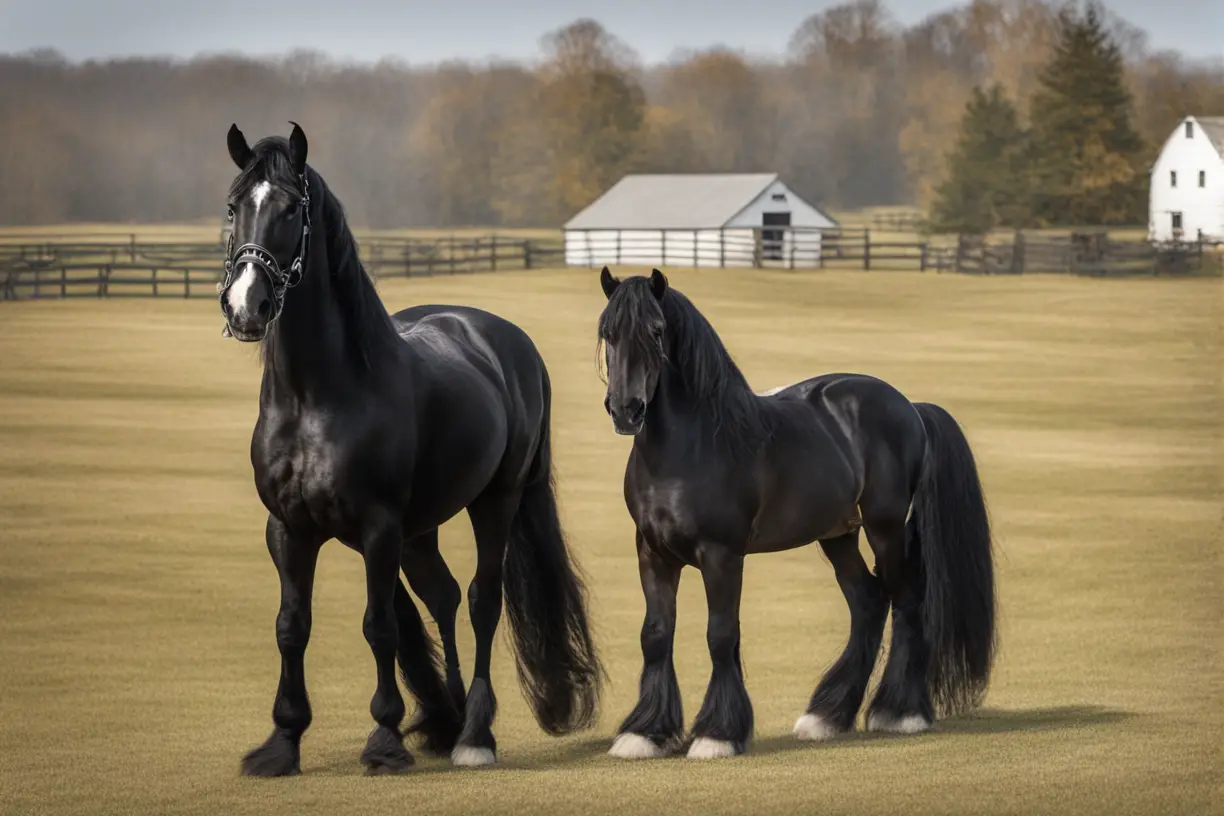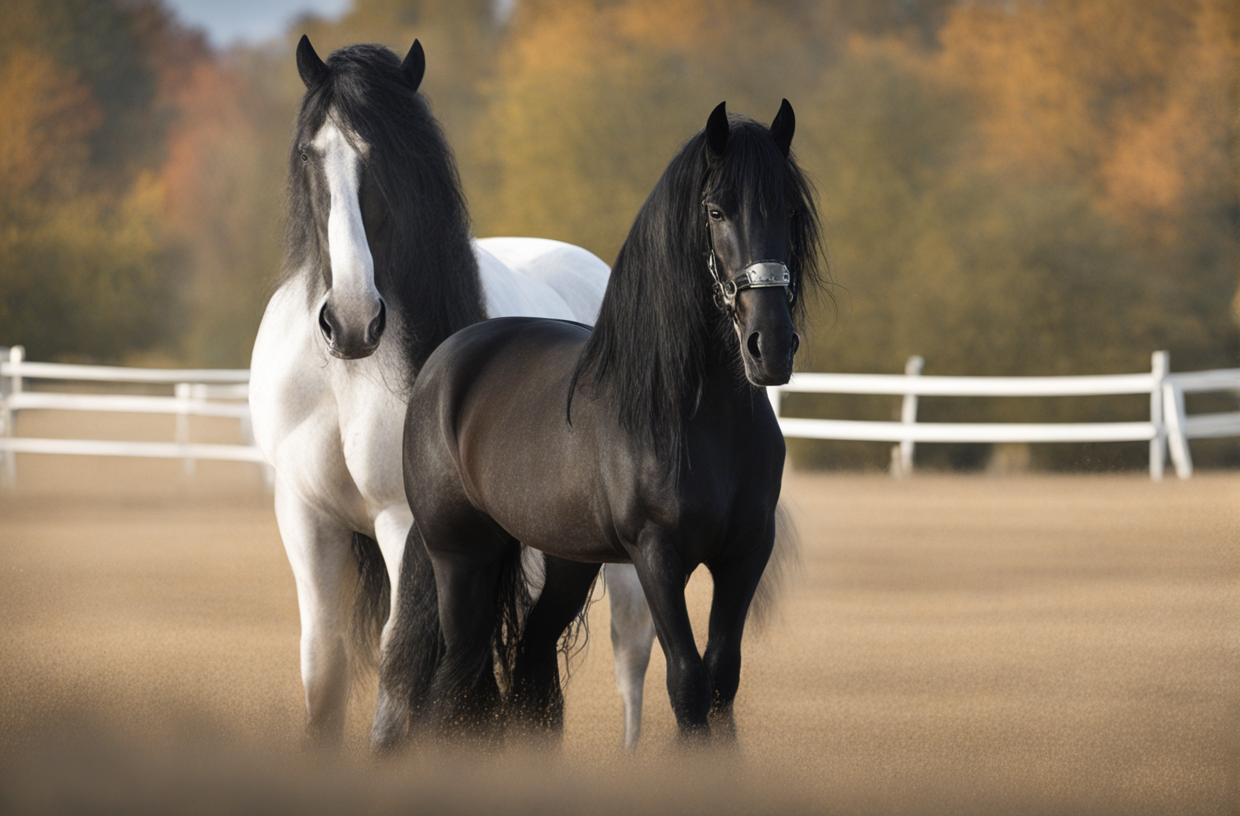Now I may just be a simple horse-lovin’ country boy, but I know a thing or two about those big beautiful draft horses we all admire.
So settle in while I jaw a bit about Friesians and Clydesdales – two of my all-time favorites!
See, last summer I had the chance to spend some time around both breeds at my buddy Jim’s farm out in Kentucky.
And let me tell you, I learned quick that these gentle giants have some key differences that prospective owners need to consider.
In a nutshell, Friesians tend to be flashier show horses while Clydesdales make hardworking farm and dray horses.
But there’s a lot more to it than that, so read on for a down home comparison from my personal experience!
Table of Contents
Appearance – Mane and Feathering
Now when it comes to looks, both these breeds will turn heads with their flowing locks. But Friesians have the edge for dramatic mane and tail feathering.

I’m talking floor-length black hair billowing in the breeze – it’s a sight to behold.
Jim’s young Friesian stallion Rogue had a thick, wavy mane that darn near touched the ground when he held his head up high. And his tail feathering was so long and full that it would drag along the ground if Jim didn’t braid it up.
Clydesdales have feathery leg hair too, but their mane and tail aren’t quite as striking and eye-catching in my opinion.
Jim’s mare Maisie had a decent amount of feathering on her legs that gave her a real elegant look, but her tail only came down to her hocks.
Don’t get me wrong – Clydesdales still have gorgeous long manes and tails compared to other breeds. But next to a Friesian they just can’t compete for drama in the hair department.
Temperament – Gentle Giants
Fortunately, both these big boys have a real gentle way about them. Friesians tend to be sweet-natured with a strong desire to bond and cooperate with people.

That Rogue was just like a big puppy dog, following me around the paddock and nuzzling my pockets looking for treats. And he loved to show off his fancy footwork once I got him trotting around the ring.
I found the Clydesdales to be just as amiable despite their intimidating size.
Maisie was so patient and unflappable – didn’t matter if I was brushing her coat, cleaning her hooves, or sitting on her bare back for the first time.
She’d just stand there completely relaxed, happy to take whatever came her way. So if you want an even-tempered horse breed, you really can’t go wrong with either a Clydesdale or Friesian.
Use – Show Horse vs Work Horse
Now here’s where you see the biggest difference between these two gentle giants.
Friesians seem naturally born to be show horses – their regal bearing, high-stepping gaits, and dramatic good looks were just made for the dressage ring or arena.

I could immediately picture Rogue prancing around with nobility in some classical dressage competition.
But Clydesdales like Maisie are more at home pulling heavy loads on the farm or a beer wagon in a parade.
With their calm disposition and immense strength, Clydesdales have tremendous stamina for all-day plowing, hauling, and just plain old farm work.
Maisie could easily plow an entire field or haul a fully-loaded wagon without getting tired. Now I know Friesians can work too, but they just seem happier getting gussied up for a show in my opinion.
Price Tag – Budget for Your Beauty
Well, purchasing either of these magnificent breeds is going to take a decent chunk of change, I’ll tell you that right now.
Due to their worldwide popularity and low breeding numbers, Friesians tend to sell for astronomical prices – anywhere from $10,000 to over $100,000! Jim said folks have paid close to $200,000 for a trained Friesian dressage competitor at some of those fancy auctions. So you’d better have some deep pockets if you want to bring one of those beauties home.
Clydesdales don’t come cheap either, but they are usually the more affordable option compared to a Friesian.
You can find a decent bloodline Clydesdale foal for around $5,000, while a trained adult might go for $15,000 or more. Still a pretty penny, but nothing like the money you’d have to fork over for a world-class Friesian dressage champion.
History – Noble Knights vs Humble Farmers
Now the history of these breeds says a lot about their different temperaments and uses today. Friesians were bred to be mighty war horses ridden by medieval knights.
Their elegant looks and nimble footwork made them status symbols among the nobility. So Friesians have centuries of refinement behind them – no wonder they act so regal!
Clydesdales have humbler roots as hardy farm horses in rural Scotland and England. They were bred specifically to haul heavy loads and plow fields for peasant farmers. So while they don’t have a noble lineage, Clydesdales do have generations of brute strength and endurance bred into them. That’s why they’re so well-suited to farming and dray horse work compared to the more highfalutin Friesian.
Training – Dressage vs Draft Work
Considering their different histories, it’s no surprise Friesians and Clydesdales are trained quite differently too.
From a young age, Friesians are handled extensively to make them receptive to dressage training. This produces willing, forward riding horses perfect for the show ring. The intricate footwork required for upper-level dressage comes easily to these intelligent, nimble animals.
Clydesdale training focuses more on developing calmness, strength and stamina. Long hours pulling loads teaches them to pace themselves and respond well to voice commands. Proper leg and harness cues are also instilled early on.
This training produces sensible, hardworking horses ideal for farming and commercial work. They may never piaffe in a dressage test, but Clydesdales sure can put in an honest day’s work!
Living Conditions – Stabled vs Pastured
Given their purpose, Clydesdales are more likely to live outside year-round, whether in small pastures or on large farms.
Their thick layers of body fat and heavy coat allow them to withstand cold weather and rugged conditions. Shelter is still important, but Clydesdales are well-equipped to spend most of their time outside.
In contrast, prized Friesians are often stabled, especially show horses. This protects their sleek coats from sun bleaching and preserves their beautiful mane and tail hair.
Daily grooming and conditioning is easier when they aren’t exposed to the elements 24/7. But some leisurely turnout is still important for any horse’s physical and mental health.
Breeding – Rare Refinement vs Common Brawn
There’s a reason Friesians are so eye-wateringly expensive – they are very rare, especially in North America.
Only a few thousand exist worldwide. Strict breeding selection has kept the breed “pure” and uniformly black. No white markings are allowed. This tight control preserves the breed’s refined look but keeps numbers low.
Clydesdales are far more common, with tens of thousands worldwide. Breeding is less tightly regulated, so you see more variation in Clydesdale size, leg feathering, and markings.
They are still beautiful, but not considered quite as rare and valuable as the highly selective Friesian. But what Clydesdales lack in refinement, they make up for in readily available numbers.
Beyond the Mane: Comparing Friesian & Clydesdale Horses for Your Stable
| Friesian | Clydesdale | |
|---|---|---|
| Origin | Netherlands | Scotland & England |
| Size | 15-17 hands | 16-18 hands |
| Weight | 1,200-1,500 lbs | 1,800-2,000 lbs |
| Coat Color | Always black | Usually bay, black, or brown |
| Feathering | Long, thick mane & tail | Long lower leg feathering |
| Temperament | Eager to please, trainable | Gentle, patient, laid-back |
| Movement | High-stepping action | Powerful but slower gait |
| Use | Carriage, dressage, shows | Farm work, pulling, parades |
| History | War horses of medieval knights | Farm horses of Scottish peasants |
| Training | Extensive dressage work | Pulling, voice commands, stamina |
| Living Conditions | Often stabled | Mostly pastured |
| Breeding | Tightly controlled, rare | More variable, common |
| Price | $10,000-$200,000 | $5,000-$15,000 |
| Right for You If… | You want a flashy, elegant show horse | You need a strong work horse |
Which is Right for You?
Well if you’ve made it this far, hopefully you’ve got a good grasp of the major differences between these two magnificent breeds.
Friesians are the drama kings – dishing out bold style, presence and movement best suited to the show ring.
Clydesdales are more humble working class heroes, but they’ve got incredible strength and stamina that makes them unmatched as farming and dray horses.
So think hard about your needs. If you love flashy looks and intricate dressage, the Friesian is your horse.
But for laidback temperament and brute force to get dirty jobs done, you just can’t beat a Clydesdale! Let me know in the comments which one you’d pick!
